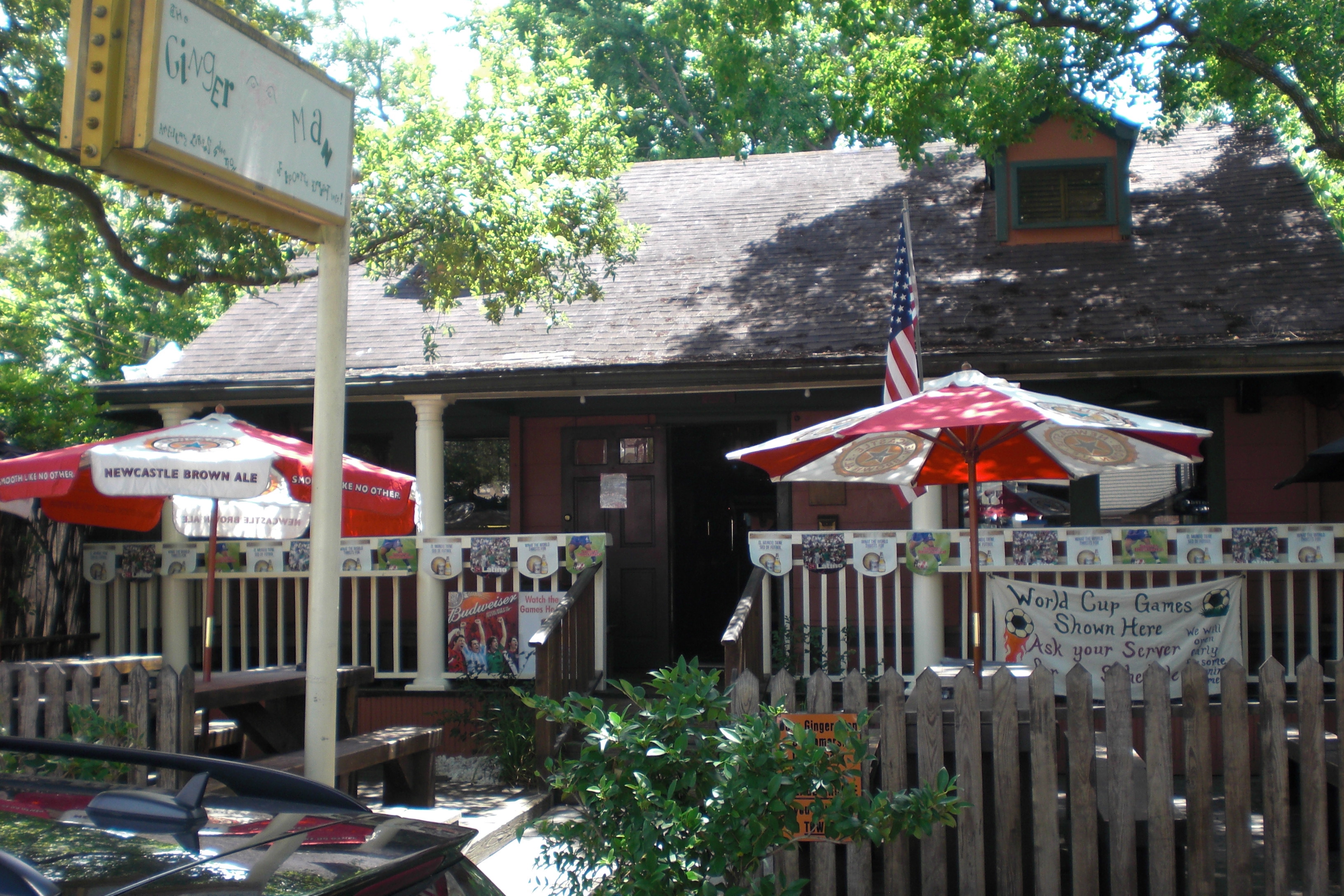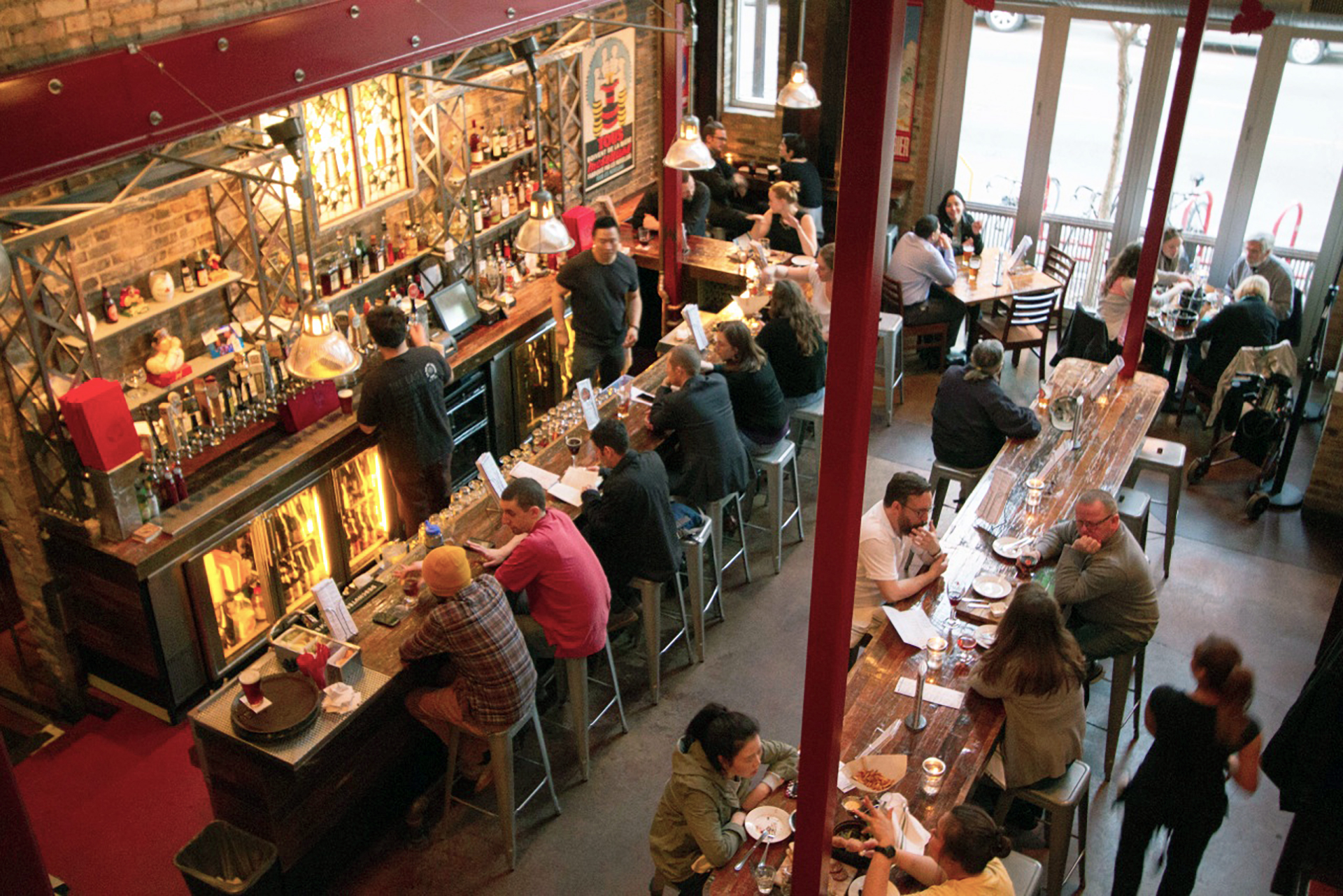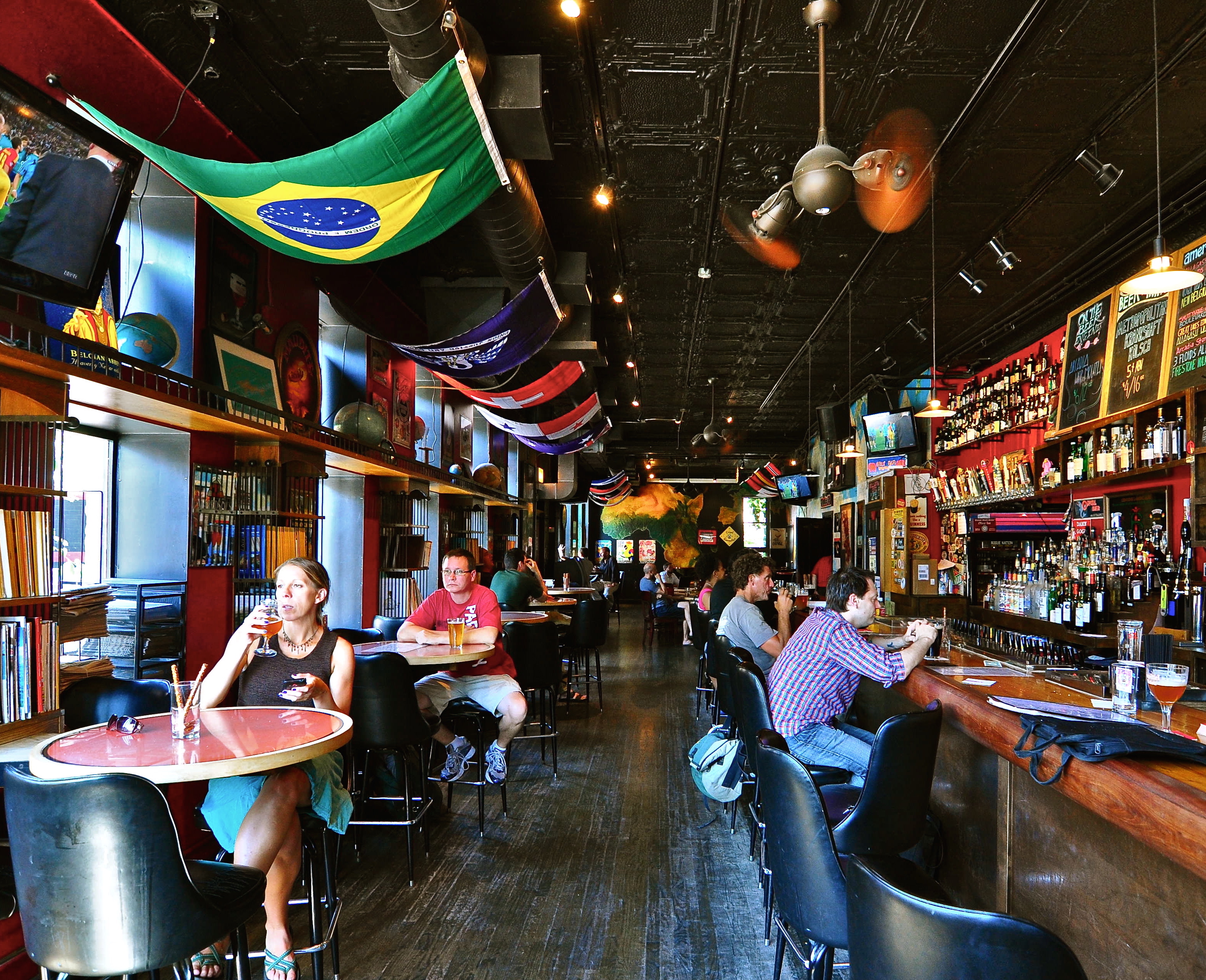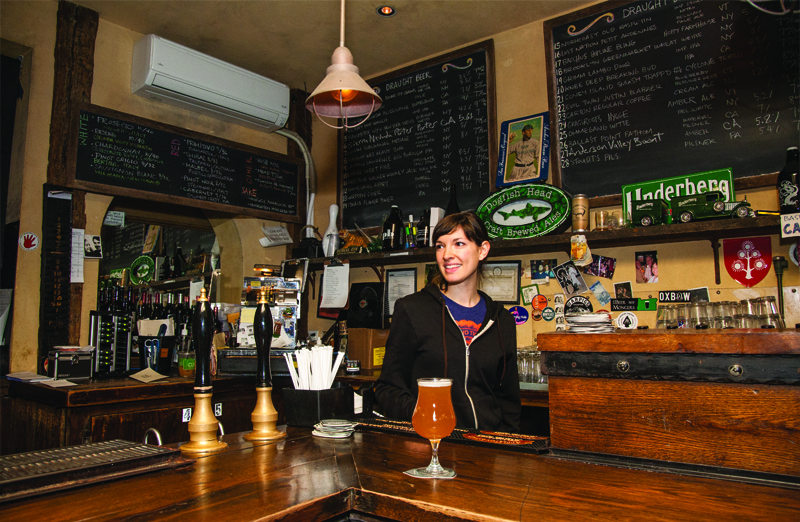Changing Times for Classic Beer Bars
Today, you can find fresh, locally brewed beer in nearly every major American city. The fact that even casual dining chains such as TGI Fridays and Buffalo Wild Wings have expanded their offerings beyond Anheuser-Busch InBev and SABMiller products in recent years is owed in part to the rise of the homebrewing movement, in part to an explosion of new breweries, and even in part to the growth of the Internet. But none of these developments would be possible without a certain number of “old guard” beer bars that have persisted for decades.

(Photo courtesy The Ginger Man)
One of the oldest of these venues is The Ginger Man, a Houston-based pub that, by 1986, was pouring carefully chosen beer from over two dozen taps, an unprecedented number for an American bar at the time. Six years later, two Chicago establishments—The Map Room and Hopleaf—would open with similar ideals of meticulous menu selection in mind. As Hopleaf founder Michael Roper explains, “I wanted people to trust our judgment in finding new [beer] that I knew that they would like. And not just something because it’s new—it had to be vetted. Eventually, customers came to trust us.”

Hopleaf in Chicago (Photo courtesy Hopleaf)
As fate would have it, a few of these trusting customers would go on to provide for the very bars that inspired them to brew. “At my first brewery job … the owner had a little spiral notebook of maybe like 20 craft beer bars in Chicago, total, and Hopleaf was chief among them,” recalls Josh Deth, owner of Chicago’s Revolution Brewing. “I was 20—not legal to drink—and these handwritten names were [already] ingrained into my psyche.” Given Hopleaf’s cachet, Deth dreamed of having his own beer served there someday. “There is a certain amount of stature about being on tap at the most highly regarded beer bars. These were the first places that had our Revolution beer on tap—where we went to first, certainly.”
Bars like these thrive in larger cities, where beer drinkers congregate and residents are willing to pay a premium to enjoy a wide array of unique experiences. Falling Rock Tap House in Denver, for example, has perhaps succeeded as much for its prime location downtown as for the wide array (more than 75 on tap and more than 135 in bottles) of beers it offers. “People go to Falling Rock …to find new interesting beer that [they] haven’t had before, not just to get the same old beer you can get at any place in the suburbs that’s in close proximity to your house,” explains Nick Nunns, owner of Denver’s TRVE Brewing. But echoing Roper of Hopleaf, Nunns also believes it’s not enough just to have “new” beer: A great beer bar must serve great beer. “If your beer is good enough to be on tap at Falling Rock, it says something about the quality of the beer that you’re brewing,” Nunns adds.
High-caliber beer bars in highly populated cities also grant more exposure to breweries that might not be centrally located. As David Lin, owner of Comrade Brewing, explains, “We’re on the southeast side of Denver, and it is a little bit far out of the way. … We definitely have a lot of customers that come in and say, ‘Hey, we had your beer at Falling Rock … and we had to come and find out where you guys are.’ That’s definitely generated some traffic for people to make the trek out to Southeast Denver.”
Many of these bars even hold special events and tastings that bring the entire community together. Falling Rock, for example, hosts an annual Fresh Hop Festival: a showcase of fresh-hopped beers from across the country, with an emphasis on brewers in the greater Colorado area. Casey Berry, co-founder of event organizer Two Parts, says, “Falling Rock is the grand papa of craft beer bars in Denver. Only the best of the best make it onto their tap wall, and this caliber [of beer] helps set the tone of the quality of beer we offer at Fresh Hop.” The bar’s reputation alone is a draw for the event.

The Map Room in Chicago (Photo by Greg Adams)
When Falling Rock opened in 1997, there were already 1,396 breweries in the United States— nearly four times as many as when Hopleaf and The Map Room opened five years earlier. As more and more microbreweries began cropping up everywhere, a symbiotic relationship began to form between brewer and bar; Falling Rock owner Chris Black, for one, came to realize Denver’s need for a place that could pour all the new local brews. By carrying small-batch beers, bars encourage the breweries to make more, Black explains. “If they don’t have an outlet for it, why are they putting in all that extra effort?”
Comrade’s David Lin appreciates this philosophy. Though Comrade is growing quickly, having doubled its output in its second year (from just over 500 barrels in 2014 to nearly 1,000 barrels in 2015), it’s still a tiny outfit in national terms and doesn’t have the means to supply a big chain bar or restaurant. “We’re putting a lot more hops in [our hoppy beers], and when trying to compete with larger breweries that have the economies of scale that we don’t, we have inherently higher production costs,” Lin explains. “So, when [bar or chain buyers] are used to seeing $65 Goose Island IPA kegs, there’s no way that we can compete with Anheuser-Busch in that arena.” A bar like Falling Rock won’t demand higher liability insurance limits or bulk discounts that a brewery like Comrade simply can’t afford.
This is because the “old guard” beer bars understand and appreciate the rarity of the beer they’re buying. Not having to answer to corporate owners means that they need not obsess over the bottom line—which also means they’re willing to take more risks on strange, experimental new brews. As Nunns puts it, “The whole point of a place like Buffalo Wild Wings is consistency across different places. At any location, you’re going to see the same beer, same wings, same menu, same layout, same decor. Those guys are not interested in us … [and] their customer base doesn’t want [our beer] either. But [our customers] don’t want to have that same light lager every day of every month of every year. They want something different based on their current mindset.”
Although brewers may be the ones working hard to create such new experiences for their customers, Josh Deth admits that “these bar owners are the ones who make a craft beer scene.” As business owners who vote on the best new beers with their tap handles, the old-guard bar owners are at the very heart of beer culture, often quite loyal to those breweries they deem are top-notch. “[Hopleaf] keeps a Revolution handle, and they’ll rotate it out when we have something new … as opposed to a bar that just rotates breweries in and out,” explains Deth. “They tend to get first pickings of some of our specialty beers, because of the long-standing relationship.”
Not only do the aforementioned bars vend extraordinary beers that have been scrutinized by knowledgeable staff—they serve them with the utmost care. “I’m a big stickler about cleaning and changing out my lines,” Chris Black insists. Falling Rock was also one of the first American establishments to serve beer in Spiegelau glassware, specifically developed to maximize beer flavor and aroma.

Blind Tiger Ale House (Photo by Jeff Quinn)
Of course, any bar that has innovated in this way must complement its world-class beer with world-class food. The Ginger Man, New York City’s Blind Tiger and Falling Rock Tap House all feature menus that push the boundaries of American bar grub. Likewise, you won’t find hamburgers, pizza or wings at Hopleaf–instead, available are dishes native to Antwerp, Belgium, such as moules-frites or roasted quail. Hopleaf’s Roper has prioritized chef-driven, farm-to-table food that not only pairs well with beer, but also is cooked with it: “We steam our mussels in beer and use it as a basis for marinades and sauces,” he explains. “We use spent grain from a local brewery and reduce beer in some of the desserts.”
By committing so wholeheartedly to the cause, these bars expose the masses to a much broader range of aromas and tastes than most individuals are used to encountering. Monk’s Cafe in Philadelphia, for example, is a veritable flavor playground, offering countless international styles from 20 taps and over 300 different bottles. Owner Tom Peters used to bet $20 with beer-averse customers that he could find one that they’d actually enjoy–and he claims he always did.
That’s not to say change has consistently been an easy sell. Roper describes the struggle to develop Hopleaf in an area of Chicago more attuned to “old-fashioned” values: “People would come in and not understand why this bar didn’t carry any of the beers they’d ever heard of. It confused people at first.” But eventually customers came to appreciate the bar’s atmosphere as one of its selling points. Without televisions or the other typical distractions of a sports bar, patrons could actually interact with one another over high quality beer.
Such an environment draws regular customers, who make for a successful business. Katherine Kyle, general manager and partner at Blind Tiger, says, “I think any bar lives and dies by its regulars. They’re the people who are going to come in regardless of whether you’re having a slow summer.” In addition, says Kyle, they educate newbies and convert them into potential beer-loving future regulars.

Toronado in San Francisco (Photo by Nick Gingold)
After finding success in their own neighborhoods, quite a few of these bars have opened in other locations, spreading the beer gospel far and wide. The trendsetting Ginger Man in Houston was one of the first to expand, with a Dallas pub opening in 1992, and eight more to follow throughout the country. Similarly, the Toronado, a divey San Francisco beer mecca since 1987, opened a new arm in San Diego four years ago, and a third last year in Seattle—both of which feature menus with great food. But no other has expanded as widely as Flying Saucer: After initially opening in 1995 in Fort Worth, Texas, the business has since expanded to 16 locations across the Southern and Midwestern United States.
“When we moved to Memphis, Tennessee, in 1997, there were no local breweries. I didn’t think we could have a complete beer list there,” says Flying Saucer partner Keith Schlabs on the impact that opening spin-offs has on local areas. ” But … there just happened to be one distributor in town who picked up 40 different [national] breweries for us. We did the same thing in Little Rock, Nashville and Raleigh, N.C. So wherever we went, we were bringing craft beer with us.”
And yet no matter how long they’ve been around, or how far they’ve extended their reach, these bars are no less relevant than when they first opened. Revolution’s Josh Deth says, “The Hopleaf has been around for a long time, but it’s such a quality establishment that I don’t consider it a thing of the past—I consider it the pre-eminent example of craft beer tavern.” Meanwhile, TRVE’s Nunns speaks of Falling Rock with almost holy reverence: “I always describe that place as Mecca. If you come to Denver, you have to go there. It’s ground zero for Great American Beer Fest for a reason: It’s one of the best beer bars in the entire country.”
Favorites aside, all of these “old guard” beer bars have collectively made an undeniable impact on the mainstream’s acceptance and understanding of beer. With their help, the public has been introduced to a much wider variety and higher quality selection of beverages than would have otherwise been possible. They are dependable, indispensable outposts—gathering places for like-minded people—that, over the last 30 years, have helped build and preserve a beer culture that simultaneously tips its hat to the past and looks to the future.
Ethan Fixell
Ethan Fixell is a comedian and freelance beverage writer from New York City.

In the 70’s Oblio’s opened in Oshkosh making sure they kept tap handles for great German beers. And as craft brews started to become available they led the city in finding new tastes and education about beers. We are lucky to find this dedication where ever we travel.